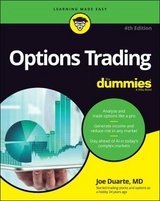
Trading Options For Dummies
John Wiley & Sons Inc (Verlag)
978-1-119-36370-5 (ISBN)
- Titel erscheint in neuer Auflage
- Artikel merken
Updated with new facts, charts, and strategies to help investors beat today’s tough markets, Trading Options For Dummies helps you choose the right options based on your investing needs. It will show you how to weigh the costs and benefits, build a strategy to gain no matter the market conditions, and broaden your retirement portfolio with index, equity, and ETF options.
Because options cost less than stocks, they’re a versatile trading instrument. If you’re an investor with some general knowledge of trading but want a better understanding of risk factors, new techniques, and an overall improved profit outcome, Trading Options For Dummies is the book for you.
Protect your investments against a decline in market prices
Increase your income on current or new investments
Buy an equity at a lower price
Benefit from an equity price's rise or fall without owning it or selling it outright
Trading options can be a great way to manage your risk, and this detailed reference gives you the expert help you need to succeed.
Joe Duarte, MD is a financial writer, private investor and trader, and former money manager/president of River Willow Capital Management. His work has been quoted in Barron's, Marketwatch.com, and The Wall Street Journal. He is the author of Trading Futures For Dummies and Market Timing For Dummies.
Introduction 1
About This Book 1
Foolish Assumptions 2
Icons Used in This Book 4
Beyond the Book 4
Where to Go from Here 4
Part 1: Getting Started 7
Chapter 1: Options Trading and the Individual Investor 9
Giving Yourself a Financial and Strategic Checkup 10
Understanding Options 11
Knowing option essentials 12
Trying different strategies before deploying them in real time 14
Putting options in their place 15
Differentiating Between Option Styles 16
Using options to limit your risk 17
Applying options to sector investing 17
Using Options in Challenging Markets 18
Reducing your directional bias and making money in flat markets 18
Controlling your emotions 19
Chapter 2: Introducing Options 21
Understanding Option Contracts 21
Tuning in to option basics 22
Comparing options to other securities 23
Valuing Options 25
Knowing your rights and obligations as an options trader 25
Terms of endearment and importance 26
Making Sense of Options Mechanics 27
Identifying options 27
Rotating with the expiration cycle 28
Options expiration is decision time 29
Detailing your rights 30
Creating Option Contracts out of Thin Air 30
Opening and closing positions 31
Selling an option you don’t own 31
Keeping Some Tips in Mind 33
Chapter 3: Trading Places: Where the Action Happens 35
The U.S Options Exchanges 36
Navigating the Markets 36
Trade execution 36
Option market participants 37
Transactions unique to options 38
Trading rules you should know 39
Weighing Option Costs and Benefits 42
Identifying costs unique to options 43
Valuing options benefits 44
Grasping Key Option Pricing Factors 47
Introducing option Greeks 48
Connecting past movement to the future 49
Chapter 4: Option Risks and Rewards 53
Understanding Your Trading Risks 54
Risking money with stocks 54
Calculating option risks 57
Reaping Your Rewards 58
Benefiting from stocks 58
Breaking even with options 59
Profiling Risk and Reward 61
Profiling stock trades with risk graphs 61
Profiling option trades with risk graphs 63
Combining option positions 65
Considering the worst-case scenario 67
Part 2: Evaluating Markets, Sectors, and Strategies 69
Chapter 5: Analyzing Mood Swings in the Market 71
A Few Words About Select Macro Factors 72
Assessing the Market’s Bias 73
Judging the strength of a move 73
(Psycho)-analyzing the market 79
Watching Call and Put Activity 81
Understanding put-to-call ratios 81
Using the put volume indicator 84
Using Volatility to Measure Fear 85
Measuring volatility 85
Recognizing impact from changing volatility 86
Spelling fear the Wall Street way: V-I-X 86
Applying Breadth and Sentiment Tools 88
Locating neutral areas for indicators 88
Identifying indicator extremes 89
Chapter 6: Sector Analysis: Technical and Fundamental 91
Getting Technical with Charts 92
Chart basics 92
Adjusting your time horizon for the best view 93
Visualizing supply and demand 94
Identifying Relatively Strong Sectors 97
Relative ratios 97
Rate of change indicator 99
Using Sector Volatility Tools 101
Displaying volatility with indicators 102
Analyzing volatility with Bollinger bands 106
Projecting Prices for Trading 107
Support and resistance 108
Trends 110
Channels 111
Price retracements and extensions 114
Projections and probabilities 116
Chapter 7: Practicing Before You Swing 119
Monitoring Option Greek Changes 120
Tracking premium measures 120
Changing volatility and option prices 121
Paper Trading a Trading Strategy 123
Trading on paper: Pluses and minuses 124
Implementing electronic paper trades 124
Using Trading Systems 125
Knowing what you’re getting 126
Performing a backtest 126
Adding risk management to a backtest 130
Shifting from Knowledge to Mastery 132
Setting the right pace 133
Achieving mastery through longevity 135
Chapter 8: Designing a Killer Trading Plan 137
Developing a Reliable Plan 138
Managing Your Costs 139
Optimizing Order Execution 141
Understanding option orders 141
Entering a new position 146
Executing a quality trade 148
Exiting an existing position 150
Part 3: What Every Trader Needs to Know about Options 153
Chapter 9: Getting to Know Different Option Styles 155
Nailing Down Index Options 155
Getting to the nitty-gritty of indexes 156
Capitalizing on an index with options 158
Watching Out for Style Risk 160
American-style options 161
European-style options 162
Exercising Your Options, American Style 164
Knowing the nuts and bolts 165
What you see is what you get 165
To exercise or not, that is the question 166
Exercising Your Options the Euro Way 167
Tracking index settlement (the SET) 167
Cashing in with exercise 167
Satisfying Option Obligations 168
American-style stock options 168
Expiring options 170
European-style options 173
Breaking It Down: American-Style Index Options 174
Exercising rights 174
Meeting obligations 175
Chapter 10: Protecting Your Portfolio with Options 177
Putting Protection on Long Stock 178
Combining puts with long stock 178
Weighing protection cost versus time 183
Limiting Short Stock Risk with Calls 185
Protecting a short stock position 185
Further reducing short stock risk 186
Hedging Your Bets with Options 187
Protecting a portfolio partially 188
Protecting a portfolio completely 191
Avoiding Adjusted Option Risk 194
Justifying option adjustments 194
Adjusting from adjustments 196
Chapter 11: Increasing Profit Potential and Decreasing Risk 199
Leveraging Assets to Reduce Risk 200
Determining your total dollars at risk 200
Relying on market timing 205
Combining Options to Reduce Risk 207
Spreading the risk with a debit trade 208
Spreading the risk with a credit trade 215
Chapter 12: Combination Strategies: Spreads and Other Wild Things 221
Combining Options with Stocks 222
Creating “covered” positions 222
Covering the covered call position 223
Reducing protected stock costs 226
Varying Vertical Spreads 228
Changing your vertical spread risk profile 229
Spreading time with calendars 230
Defining diagonal spreads 233
Chapter 13: ETFs, Options, and Other Useful Tricks 237
Exploring the Exchange-Traded Fund 237
Comparing ETFs to indexes 238
Distinguishing ETF and index options 241
Reducing Portfolio Volatility with ETFs 244
Revisiting volatility 244
Investing with ETFs 249
Tilting Your Portfolio with Sector ETFs 256
Adding sector ETFs to tilt your portfolio 256
Selecting the right strategy 260
Part 4: Advanced Strategies for Options Traders 263
Chapter 14: Making Money without Worrying About the Market’s Direction 265
Limiting Directional Risk 266
Capitalizing on a big move 266
Reducing straddle risk and reward 272
Neutral View versus Neutral Position 275
Identifying neutral positions 276
Calculating delta for combination positions 276
Trading with Delta 277
Monitoring two key Greeks 278
Creating a delta neutral straddle 279
Understanding Trade Adjustments 282
Deciding when to adjust a trade 283
Deciding how to adjust a trade 284
Chapter 15: Letting Volatility Show You the Way to Trading Opportunities 285
Analyzing Implied Volatility Levels 286
It’s all relative but not overly scientific 286
When options are skewed 293
Understanding Ratio Spreads 296
Reviewing ratio spread risk profiles 296
Identifying best conditions for ratio spreads 300
Deciding your strategy 301
Using Ratio Backspreads 303
Defining ratio backspreads 303
Spotting best conditions for ratio backspreads 312
Chapter 16: Trading Profitably When Markets Move Sideways 315
Winning Positions in Sideways Markets 316
Managing existing positions 316
Option strategies for sideways moves 321
Understanding Butterfly Positions 323
Defining the butterfly 324
Digging deeper into butterfly risk 332
Creating an iron butterfly 334
Understanding Condor Positions 338
Defining a condor spread 338
Recognizing condor risks 340
Part 5: The Part of Tens 343
Chapter 17: Ten Top Option Strategies 345
Married Put 346
Collar 347
Long Put Trader 348
LEAPS Call Investor 349
Diagonal Spread 351
Bear Call Credit Spread 352
Straddle 353
Call Ratio Backspread 355
Put Ratio Backspread 356
Long Put Butterfly 357
Chapter 18: Ten Do’s and Don’ts in Options Trading 359
Do Focus on Managing Risk 360
Don’t Avoid Losses 361
Do Trade with Discipline 361
Don’t Expect to Remove Your Emotions 362
Do Have a Plan 363
Do Be Patient 364
Don’t Suffer from Analysis Paralysis 365
Do Take Responsibility for Your Results 365
Don’t Stop Learning 366
Do Love the Game 367
Index 369
| Erscheinungsdatum | 29.10.2017 |
|---|---|
| Verlagsort | New York |
| Sprache | englisch |
| Maße | 198 x 233 mm |
| Gewicht | 530 g |
| Themenwelt | Sachbuch/Ratgeber ► Beruf / Finanzen / Recht / Wirtschaft |
| Wirtschaft ► Betriebswirtschaft / Management ► Finanzierung | |
| ISBN-10 | 1-119-36370-5 / 1119363705 |
| ISBN-13 | 978-1-119-36370-5 / 9781119363705 |
| Zustand | Neuware |
| Informationen gemäß Produktsicherheitsverordnung (GPSR) | |
| Haben Sie eine Frage zum Produkt? |
aus dem Bereich



